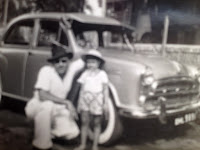The Tool Drawer *
![antique-jacobean-style-oak-dresser-base-sideboard-sold-[2]-1954-p.jpg (712×641)](https://www.harrisonantiquefurniture.co.uk/ekmps/shops/timharrison/images/antique-jacobean-style-oak-dresser-base-sideboard-sold-[2]-1954-p.jpg)
Growing up in Mumbai in the early-1960s, my sisters and I would sometimes gaze awestruck at the old china and tableware in our dining-room sideboard.
We siblings had no idea then about the origins of these artifacts from another time. Nine, four and two, we were too young to be aware of the British retreat from India about a decade earlier, or about the detritus of colonisation they had left behind. Fifty years later, I still don’t know how these objects came into our possession. Today, however, I feel ambivalence, not awe, about these objects that once had such pride of place in our home.
Occasionally, my sisters and I were caught handling the china and rebuked by adults in the family. One day, we discovered the top left-hand drawer of the sideboard with its mélange of rough-hewn pieces of metal and wood. The drawer was heavy. My sisters and I held on to the handle and pulled with all our might. The drawer flew out into our hands, we fell backwards, and its contents clattered on to the floor. We, to our surprise, were unhurt. But we were told never to open that drawer again.
However, my father, who was good at fixing things, taught me to identify the different tools in the drawer, which is what those strange objects turned out to be. So when he had to tighten a loose screw or repair a fixture and needed a tool, I would cry out, “I’ll get it!”, rush to find the tool and hand it to him.
I also discovered, inside the drawer, an assortment of cockroaches seeking refuge from the spraying that our maid undertook periodically. I experienced a certain thrill in grabbing a tool before a curious insect could explore my hand. This was where I first observed insect life at close quarters, opening the drawer slightly and peering in through the crack. And this was where I would come, years later, to catch home-grown specimens for dissection in my school’s biology lab.
In 2011, I travelled to Mumbai for a last visit with my ailing mother. Reminiscing, I mentioned those adventures involving our sideboard, but there was no sign of recognition from my mother or my sisters.
So, was I the only one with those memories? My sisters had probably been too young to remember, and my mother seemed to gloss over most things at the time except those that dealt with her illness. I wondered about those old tools and thought that perhaps they had been lost in the flurry of our family’s collective and then separate moves.
Historian-philosopher Tzvetan Todorov says our memories represent only a part of what actually transpired, and that the meanings we construct largely overshadow the facts that were involved. Human memory is essentially “reconstructive, never a literal replay of past events”, in the words of social psychologist Elliott Aronson.
One morning, during that 2011 visit, when I was searching for a spare set of keys, I happened to look into a small kitchen drawer. And there they were, neatly arranged — every last one of the tools I remembered from my childhood
Chuckling and delighted, I lifted them out one by one, looking at them closely and feeling their familiar shapes. Half-consciously, I was also listening for the scraping sound of insects and was ready to drop the tools at the first contact with a soft feeler. But nothing happened, and I pushed the drawer back in, feeling as though this time I was nestling my memories there as well for safekeeping.
Objects in our lives anchor our memories. They help to preserve a sense of continuity especially after great change including death and destruction. In his book The End, about the British bombing of Hamburg in the summer of 1943, Hans Erich Nossack wrote about the disorienting experience of completely losing everything. He described how even if one little object had somehow survived the devastation of the firestorms, it would have become “imbued with the essence of all the other things” — precisely in the way the tool drawer became a doorway for me to a whole world of precious memories.


Comments
Post a Comment